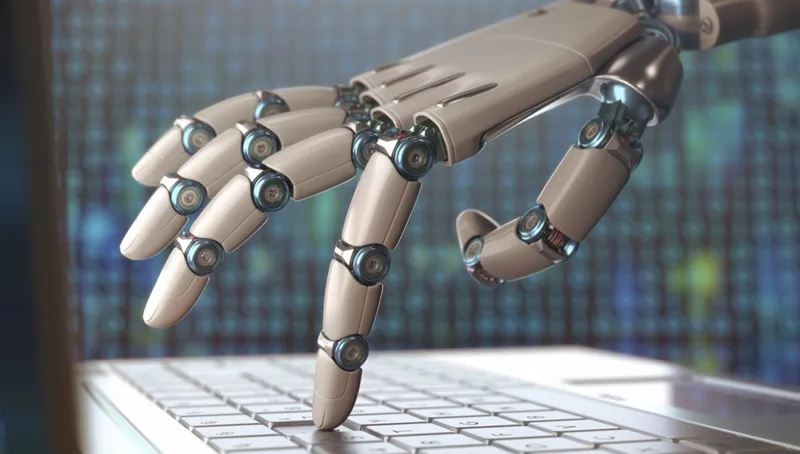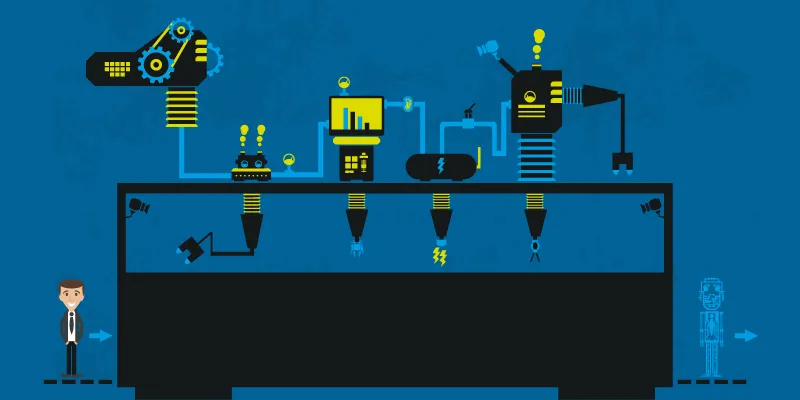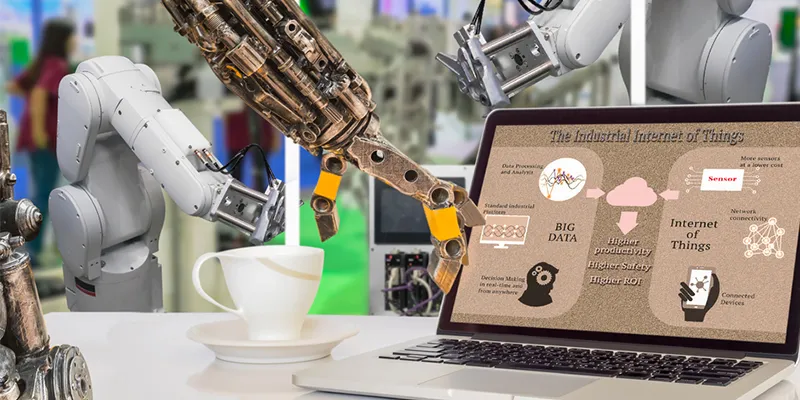Inside Mindtree’s workforce automation, ‘bot’ deployment and employee upskilling
The era of automation is upon us, and IT major Mindtree has pioneered a work culture where man and human-like machines can co-exist to maximise growth.
Mindtree, one of India’s largest IT and business process outsourcing companies, has been at the forefront of emerging tech adoption. The $840 million organisation was among the early initiators of ‘bots’ in the workforce two years ago.
Since then, bots (or “virtual employees” as they are called) have automated core organisational processes, increased efficiencies, reduced friction and improved overall work environment at Mindtree. Or so it claims.
The company says that of its 17,700-strong workforce, about 350 are bots that work 24X7, and help increase the satisfaction of ‘Mindtree Minds’ - its human workforce. Not only do these bots free up “precious time for teams to focus on larger objectives such as strategy and innovation”, but also help eliminate human errors, break the monotony of human-intensive tasks, and standardise outcomes.

The human workforce, on the other hand, dedicates itself to roles that require a human interface, and run on human intelligence. Employees are also engaged in creating, designing and deploying tasks to the bots, and re-imagining business processes. It helps “Mindtree minds to be multi-skilled and to take up higher order responsibilities,” says the company.
What are ‘bots’ and what do they do at Mindtree?
What really are ‘bots’, and why are they gaining ground so quickly? So much so that the global industrial automation market is estimated to grow to $352 billion by 2024, according to Transparency Market Research.
‘Bots’ are essentially computer-generated programmes that act autonomously and perform significant tasks that are otherwise assigned to humans. They are typically deployed to perform ‘scheduled’ or repetitive tasks that are both human-intensive and time-consuming.
These bots can perform tasks that have “standard operating procedures” at a much faster pace than humans do, hence improving productivity, optimising costs, and accelerating organisation growth. “All roles which follow rules will get eventually automated with bots,” veteran HR professional Abhijit Bhaduri tells YourStory.
At Mindtree, bots “have helped various process areas to improve reliability, efficiency and quality,” says Rajesh Kumar R, Head of Automation at Mindtree. “Also, automation has given more opportunity to create interesting work rather than routine repetitive tasks, which in turn, has attracted talented engineers who are excited to do challenging and innovative work,” he adds.

There is measurable impact too. Mindtree claims bots have helped reduce its turnaround time by 75 percent. It has also brought down costs of operation in infrastructure and application maintenance projects by 20-40 percent.
“In some cases, it has helped reduce critical issues by 90 percent. Bots can monitor, detect anomalies and inform engineers on critical issues immediately, and even with probable solutions from past experience,” Rajesh says.
Tasks that have been automated
There are core areas which Mindtree has identified where bots can have maximum impact.
Rostow Ravanan, MD and CEO of Mindtree, says,
“We started with evaluating all processes within Mindtree, both in the projects we do for our customers, as well as internal processes such as payroll, expense reimbursements etc. We identified cases where the process requires repetitive activities which follow a determinable decision- making pattern. Using technology, we have started automating all such activities.”
Tasks that have been automated include serving user access requests to various applications or systems, checking the health of systems or applications and periodic reporting of it, starting maintenance tasks like managing jobs, clearing caches etc, updating website content, monitoring emails, creating auto tickets for service requests, and generating letters to banks for real-time payments.

Rostow adds,
“Doing so has given us two advantages: higher people satisfaction within these teams because they have been freed from the mundane, repetitive activities, and can devote their time to more value added work, and learn new skills etc; and higher quality, reliability and improved productivity.”
So, it is a win-win for both man and machine.
Still man ‘versus’ machine?
Despite the utility of bots, the general concern surrounding human job losses that automation can bring about refuse to die down. There is widespread belief that bots, or the “second machine age” as some call it, will replace tens of millions of human jobs and clock in several thousands of human work hours in the years to come.
In a 2017 report, global consulting firm McKinsey outlined that “by 2030, between zero and 30 percent of the hours worked globally could be automated. While there may be enough work to maintain full employment to 2030 under most scenarios, the transitions will be very challenging — matching, or even exceeding the scale of shifts out of agriculture and manufacturing we have seen in the past.”
While the challenges posed by automation are real, it might be a tad alarmist to believe new job creation will not occur. Or so thinks Mindtree, whose own workforce is testimony to the fact that man and machine can co-exist.
Rajesh explains,
“Bots did not replace people at Mindtree. If we classify the work into routine and non-routine work, bots are deployed to take up the routine and repetitive work that can be formulated into a standard operating procedure. Human roles can’t be said to have shrunk, instead the automation and bot deployments have freed up our work for Mindtree minds to take up larger roles where human cognition is critical, such as architecture, creating solutions, designs, coding and of course designing the automations for the routine and repetitive tasks.”
Mindtree asserts that the introduction of bots has not had any impact on its hiring strategy. On the contrary, they have opened up exciting new roles for human workers.
“While the question in the short-term is about impact to employment, eventually, it will open up a lot more opportunities, like the advent of ATMs for banks only enabled banks to open up a lot more branches and scale at a rapid pace creating more jobs and enhancing their customer service,” Rajesh adds.

Technologies powering the Mindtree bots
Robotic process automation, Machine Learning (ML) and Conversational Engines are the technologies behind Mindtree’s bots. In most cases, they replicate human actions to perform “rule-based tasks”.
In complex scenarios, where decisions have to be taken dynamically and in real-time, Artificial Intelligence (AI) and deep learning techniques are employed. In conversational scenarios, where active human interaction is needed, Natural Language Processing (NLP) engines are used.
Interestingly, several human-interface roles like client servicing and customer support are witnessing the intervention of bots too.
Rajesh explains,
“Technologies like AI, ML and NLP are capable of identifying unique clients or customers, analysing their data patterns, and providing insights on their attributes to predict their behaviour with a certain degree of confidence. The basic needs of clients and customers which consume a higher percentage of service or support effort can be substituted by conversational bots.”
The company says at times, customers prefer bots over humans because they are more methodical and consistent. That again raises the moot question: where do humans stand when bots become conversational and intelligent like them?
The answer lies in what McKinsey calls “skill shifts” or workforce reskilling.
HR guru Bhaduri says,
“Companies have to invest in reskilling. But it is the individual who must take an active role in defining the kind of roles they want to take and the skills they wish to build.”
Workforce reskilling and upskilling
The age of automation makes it imperative for the workforce to reskill and upskill. Mindtree recognised the need to “multi-skill” its human workforce in order to keep it relevant as bots took over their routine jobs.
The IT major set up Yorbit, a virtual learning platform that skills the human workforce to handle complex jobs. Labs have been established to conduct hands-on exercises to develop bots. Upskilling is also being addressed through career development plans, project-specific guidance, certifications, e-learning courses, workshops and webinars.
Rajesh says,
“We have dedicated automation consultants and engineers who engage with our team or even with customers and identify the automation areas, come up with solution designs and take them through the complete automation life cycle.”
Mindtree has also established Automation Center of Excellence (CoE) teams that support various areas like robotic process automation, machine learning, conversational bots and IoT. Several “automation accelerators” and platforms have also been built.
All this has, of course, come at a cost. But, Mindtree refuses to divulge any numbers.
Rajesh says, “The investments on automation are organisation-wide. We have made it easier for our teams to bring in the technologies by providing them additional budgets because the benefits are worth it.”

Overcoming roadblocks
Any transformation is difficult and entails its own set challenges. Warming up to the automation era was no different.
For Mindtree, the foremost challenge was bringing about a “cultural change” and developing a “mindset to adopt automation without fear”.
The company developed awareness and education programmes for its employees. They were encouraged to build automation solutions even while doing monotonous tasks. On the client side, there were “healthy discussions, and proof-of-concepts built to bring them to a safe and comfort zone,” says Rajesh. “Post this, everyone was fervent to ideate, innovate and implement solutions to make their lives easy.”
He shares an incidence when Mindtree’s IT team provided production support off business hours on a weekend. It was done entirely through bots. Instant alerts were activated, and real-time escalations were done without any human intervention.
Rajesh says, “Engineers will obviously welcome such bots to be a part of their teams, sharing their load with them.”
What the future holds
More machines, more tasks, more productivity, more growth.
Mindtree says it will keep experimenting with bots, add to their count, and automate greater business processes.
On the enterprise level, too, Mindtree has developed automation platforms. There is Mindflow, a conversational platform that can integrate, orchestrate, automate with different NLP engines and create chatbots for other businesses, CAPE (Composable Automation Platform), an IT automation meta-platform for enterprises, and RAPID, a robotic process automation framework for BPO and IT operations.
“Automation is now touching upon the so-called ‘knowledge worker’ areas which were once thought to be non-automatable,” says Rajesh, “and this is just the beginning. Far more cognitive tasks will be automated in the coming years.”
The industry concurs.
McKinsey says in its report, “Over the next 15 years, AI technologies will transform the workplace as people increasingly interact with ever-smarter machines. These technologies, and that human-machine interaction, will bring numerous benefits in the form of higher productivity, GDP growth, improved corporate performance, and new prosperity.”







